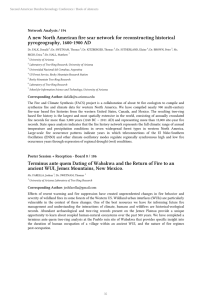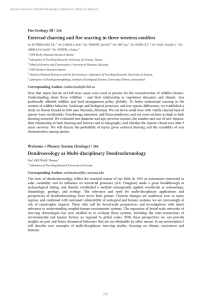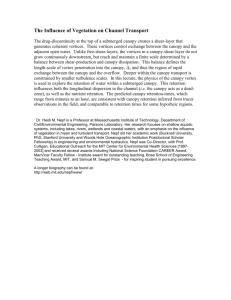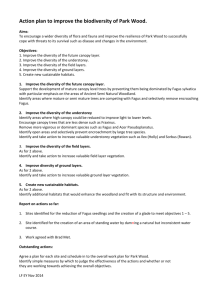Electronic Supplementary Material for: Changes in soil
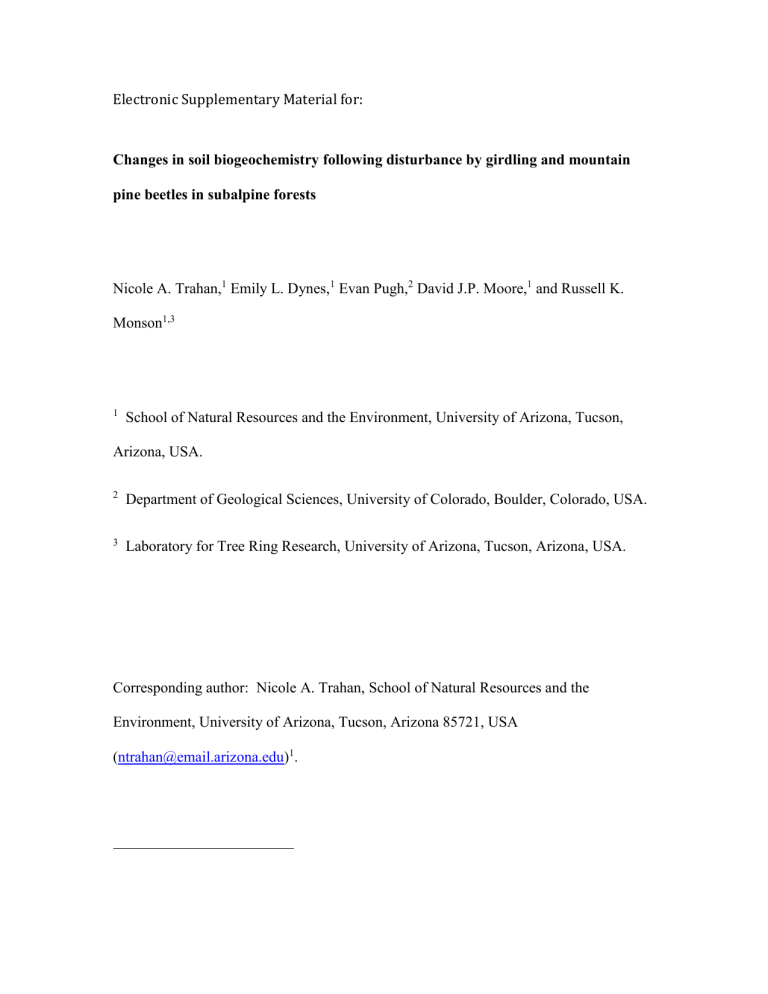
Electronic Supplementary Material for:
Changes in soil biogeochemistry following disturbance by girdling and mountain pine beetles in subalpine forests
Nicole A. Trahan, 1 Emily L. Dynes, 1 Evan Pugh, 2 David J.P. Moore, 1 and Russell K.
Monson
1,3
1
School of Natural Resources and the Environment, University of Arizona, Tucson,
Arizona, USA.
2
Department of Geological Sciences, University of Colorado, Boulder, Colorado, USA.
3
Laboratory for Tree Ring Research, University of Arizona, Tucson, Arizona, USA.
Corresponding author: Nicole A. Trahan, School of Natural Resources and the
Environment, University of Arizona, Tucson, Arizona 85721, USA
( ntrahan@email.arizona.edu
)
1
.
Online resource one: detailed dendrochronology methods
Subsequent to the establishment of the chronosequence, we employed dendrochronological techniques that allowed us to more accurately determine year of tree death within our plots. In mid-August 2012, we re-visited the site and took two cores parallel to the slope at 1.3 m of all trees within the plots measuring greater than 10 cm in dbh, using a 5.1 mm diameter increment borer (Haglof Company Group, Langsele,
Sweden). We mounted and sanded the cores, measuring the width of each growth ring to
0.01 mm using the LINTAB tree-ring measurement station (LINTAB
TM
5, Rinntech Inc.
Heidelberg, Germany). The live tree data was compiled into a site master with known outside ring dates to allow cross-dating the dead trees. To assign a preliminary year of death, we performed a Pearson’s correlation coefficient analysis ( P < 0.001
, CI = 0.3281) of ring widths in the samples and the master chronology using COFECHA (Holmes
1983). To verify statistical crossdating and assign a robust year of death, we used the
Math Graph function of TSAP-Win to visually compare the ring-width series of the individual dead cores against the standardized ring-width series of the master chronology
(TSAP-Win, Rinn 2003 (Rinntech Inc. Heidelberg, Germany) (Grissino-Mayer 2001;
Jones and Daniels 2012). We iteratively dated samples using the correlation of ring widths between robustly dated and undated samples until all samples were dated. Due to the aggregate nature of bark beetle attacks, all focal trees with in a plot were attacked in the same year, with the exception of four of the 18 Fraser Experimental Forest plots, that each had a single tree that differed ±1 one year in time since disturbance as compared to the rest of the grouping. All results and analysis in the associated paper reflect the dendrochronologically determined year of mortality for time since disturbance.
References:
Grissino-Mayer H (2001) Evaluating crossdating accuracy: A manual and tutorial for the computer program COFECHA. Tree-Ring Res 57:205-221
Holmes R (1983) Computer-assisted quality control in tree ring dating and measuring.
Tree-Ring Bull 43:69-75
Jones E, Daniels L (2012) Assessment of dendrochronological year-of-death estimates using permanent sample plot data. Tree-Ring Res 68:3-16
Online resource two: detailed methods for calculating plant area index, canopy openness, and total transmitted light:
To calculate plot scale plant area index (PAI), four hemispherical photos were taken per plot in the Fraser beetle-kill chronosequence, one in each cardinal direction surrounding and approximately 5 m away from the plot center. Images were taken 1 m above the ground using a Nikon D700 camera and Sigma EX 8 mm Fisheye lens georeferenced to north and leveled to gravity. Once acquired, images were processed using Gap Light Analyzer software (Frazer et al. 1999) and PAI was integrated over the zenith angles 0 to 60 ° (Stenberg et al. 1994). Plant area index includes the single-sided shadow potential of all aboveground plant parts. Canopy openness was determined as the percentage of the total sky area that is found in canopy gaps for each sky region. Gap
Light Analyzer software was also used to model transmitted light flux through the canopy from July 1 - July 31, 2011, a time representative of forest growing season photosynthetic activity. The percent total light transmitted is the ratio of radiation incident on the plot surface when there is blockage of light from the surrounding topography and overlying forest canopy. Total transmitted light (%) was calculated using a 2-minute solar step, a cloudiness index of 0.5 (Hardy et al. 2004), a spectral fraction (0.25–25 mm) of 1.0 MJ
m
-2 d
-1
, a beam fraction of 0.5, a clear-sky transmission coefficient of 0.7, and an assumed solar constant of 1367 W m
-2
.
References:
Frazer GW, Canham CD, Lertzman KP (1999) Gap Light Analyzer (GLA), Version 2.0:
Imaging software to extract canopy structure and gap light transmission indices from true-colour fisheye photographs, users manual and program documentation.
Simon Fraser University, Burnaby, British Columbia, and the Institute of
Ecosystem Studies, Millbrook, New York
Hardy J, Melloh R, Koenig, G, Marks D, Winstral A, Pomeroy J, Link T (2004) Solar radiation transmission through conifer canopies. Agr Forest Meteorol 126:257-
270. doi: 10.1016/j.agrformet.2004.06.012
Stenberg P, Linder S, Smolander H, Flowerellis J (1994) Performance of the LAI-2000
Plant Canopy Analyzer in estimating leaf-area index of some Scots pine stands.
Tree Physiol 14:981-995
